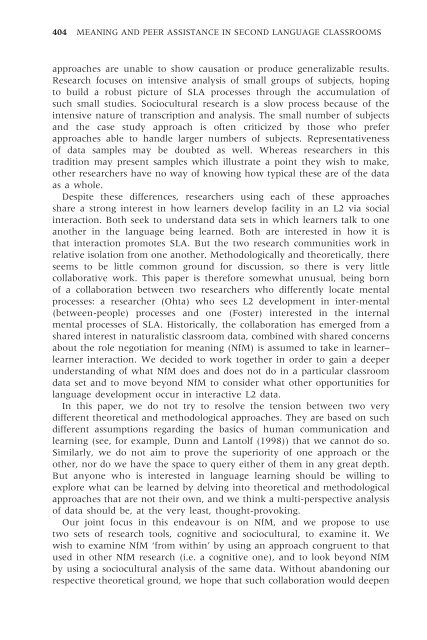Negotiation for Meaning and Peer Assistance in Second Language ...
Negotiation for Meaning and Peer Assistance in Second Language ...
Negotiation for Meaning and Peer Assistance in Second Language ...
Create successful ePaper yourself
Turn your PDF publications into a flip-book with our unique Google optimized e-Paper software.
404 MEANING AND PEER ASSISTANCE IN SECOND LANGUAGE CLASSROOMS<br />
approaches are unable to show causation or produce generalizable results.<br />
Research focuses on <strong>in</strong>tensive analysis of small groups of subjects, hop<strong>in</strong>g<br />
to build a robust picture of SLA processes through the accumulation of<br />
such small studies. Sociocultural research is a slow process because of the<br />
<strong>in</strong>tensive nature of transcription <strong>and</strong> analysis. The small number of subjects<br />
<strong>and</strong> the case study approach is often criticized by those who prefer<br />
approaches able to h<strong>and</strong>le larger numbers of subjects. Representativeness<br />
of data samples may be doubted as well. Whereas researchers <strong>in</strong> this<br />
tradition may present samples which illustrate a po<strong>in</strong>t they wish to make,<br />
other researchers have no way of know<strong>in</strong>g how typical these are of the data<br />
as a whole.<br />
Despite these differences, researchers us<strong>in</strong>g each of these approaches<br />
share a strong <strong>in</strong>terest <strong>in</strong> how learners develop facility <strong>in</strong> an L2 via social<br />
<strong>in</strong>teraction. Both seek to underst<strong>and</strong> data sets <strong>in</strong> which learners talk to one<br />
another <strong>in</strong> the language be<strong>in</strong>g learned. Both are <strong>in</strong>terested <strong>in</strong> how it is<br />
that <strong>in</strong>teraction promotes SLA. But the two research communities work <strong>in</strong><br />
relative isolation from one another. Methodologically <strong>and</strong> theoretically, there<br />
seems to be little common ground <strong>for</strong> discussion, so there is very little<br />
collaborative work. This paper is there<strong>for</strong>e somewhat unusual, be<strong>in</strong>g born<br />
of a collaboration between two researchers who differently locate mental<br />
processes: a researcher (Ohta) who sees L2 development <strong>in</strong> <strong>in</strong>ter-mental<br />
(between-people) processes <strong>and</strong> one (Foster) <strong>in</strong>terested <strong>in</strong> the <strong>in</strong>ternal<br />
mental processes of SLA. Historically, the collaboration has emerged from a<br />
shared <strong>in</strong>terest <strong>in</strong> naturalistic classroom data, comb<strong>in</strong>ed with shared concerns<br />
about the role negotiation <strong>for</strong> mean<strong>in</strong>g (NfM) is assumed to take <strong>in</strong> learner–<br />
learner <strong>in</strong>teraction. We decided to work together <strong>in</strong> order to ga<strong>in</strong> a deeper<br />
underst<strong>and</strong><strong>in</strong>g of what NfM does <strong>and</strong> does not do <strong>in</strong> a particular classroom<br />
data set <strong>and</strong> to move beyond NfM to consider what other opportunities <strong>for</strong><br />
language development occur <strong>in</strong> <strong>in</strong>teractive L2 data.<br />
In this paper, we do not try to resolve the tension between two very<br />
different theoretical <strong>and</strong> methodological approaches. They are based on such<br />
different assumptions regard<strong>in</strong>g the basics of human communication <strong>and</strong><br />
learn<strong>in</strong>g (see, <strong>for</strong> example, Dunn <strong>and</strong> Lantolf (1998)) that we cannot do so.<br />
Similarly, we do not aim to prove the superiority of one approach or the<br />
other, nor do we have the space to query either of them <strong>in</strong> any great depth.<br />
But anyone who is <strong>in</strong>terested <strong>in</strong> language learn<strong>in</strong>g should be will<strong>in</strong>g to<br />
explore what can be learned by delv<strong>in</strong>g <strong>in</strong>to theoretical <strong>and</strong> methodological<br />
approaches that are not their own, <strong>and</strong> we th<strong>in</strong>k a multi-perspective analysis<br />
of data should be, at the very least, thought-provok<strong>in</strong>g.<br />
Our jo<strong>in</strong>t focus <strong>in</strong> this endeavour is on NfM, <strong>and</strong> we propose to use<br />
two sets of research tools, cognitive <strong>and</strong> sociocultural, to exam<strong>in</strong>e it. We<br />
wish to exam<strong>in</strong>e NfM ‘from with<strong>in</strong>’ by us<strong>in</strong>g an approach congruent to that<br />
used <strong>in</strong> other NfM research (i.e. a cognitive one), <strong>and</strong> to look beyond NfM<br />
by us<strong>in</strong>g a sociocultural analysis of the same data. Without ab<strong>and</strong>on<strong>in</strong>g our<br />
respective theoretical ground, we hope that such collaboration would deepen














